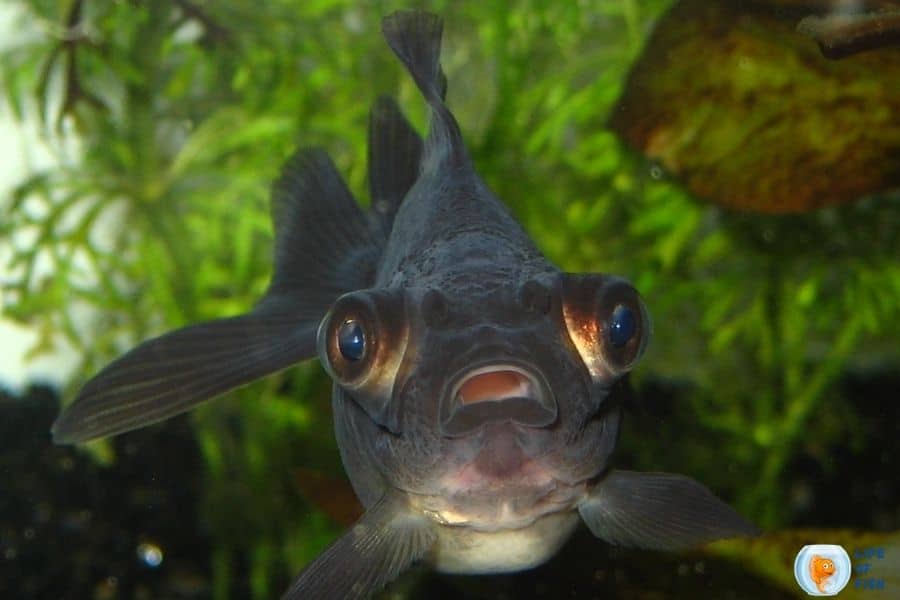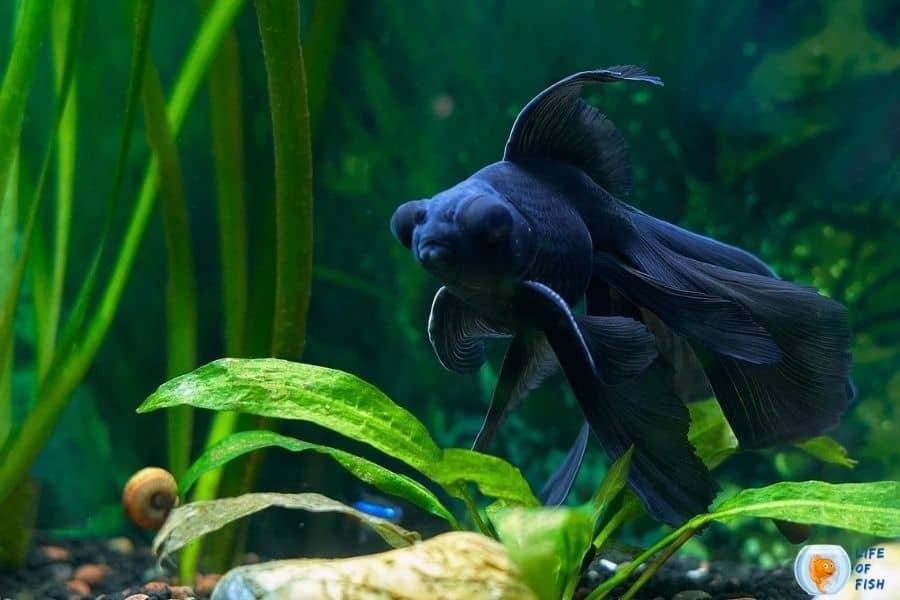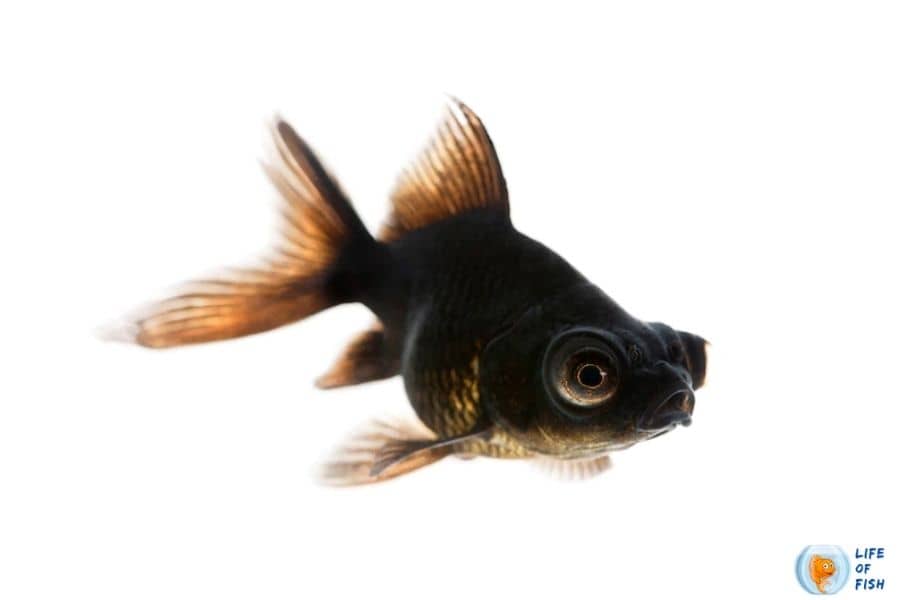Knowing black moor goldfish diseases before your fish gets sick is the best way to prevent infection. Therefore, this article will go over some of the most prevalent ailments that affect black moor goldfish.
Introduced in the early 1400s in China, Black moor goldfish is one of the most sought-after goldfish types globally.
They are so popular because they are among the hardiest fancy goldfish breed. Even though black moors are hardy, they are prone to several diseases because of their telescopic eyes, body shape, and long fins.
So, you have to provide extra care for these cute little fish than the common goldfish.

Protozoa diseases
Jump To
One of the most common diseases of black moor goldfish is protozoa disease. Single-celled parasites are responsible for the disease and can affect all fish, including black moor goldfish.
Protozoa diseases can cause several symptoms in black moor goldfish, including lethargy, loss of appetite, abnormal swimming, white spots on the body and fins, and increased mucus production. Some of the common protozoa diseases are,
01. Ichthyophthirius multifiliis
This is a highly contagious protozoan disease that causes white spots on the body and fins of infected fish. The spots are actually the parasite’s egg sacs, containing hundreds of parasites.
Sudden change in temperature or water quality caused Ich to emerged and can kill fish within days.
The best way to prevent ich in black moors is to maintain a stable environment for your fish and quarantine new fish before introducing them to your tank.
02. Costia necatrix
This protozoan parasite is a rare cause of goldfish diseases. It can cause several symptoms, including lethargy, loss of appetite, abnormal swimming, and white patches on the body and fins.
Costia is treated with a medication called Acriflavine, which is available from most pet stores. You can also treat your fish with copper.
However, both medications can be lethal to your fish if used improperly, so it’s best to consult a veterinarian before using them.
03. Chilodonella
Chilodonella is another protozoan disease that can cause blue patches on the body and gills of infected fish. Your fish will show symptoms like difficulty breathing, clamped fins, irritations, and lethargy.
Chilodonella is treated with a medication called Acriflavine. However, you should change the water soon after you see an improvement in your fish because Acriflavine can sterilize your goldfish.
Parasite diseases
Parasite diseases are more common in fish tanks. These diseases are caused by a variety of parasites, including flukes, worms, and leeches.
Parasite diseases can cause a number of symptoms in black moor goldfish, including lethargy, loss of appetite, abnormal swimming, and white spots on the body and fins. Some of the most common parasite diseases are,
04. Fish lice (argulus)
Fish lice are small, parasitic crustaceans that attach themselves to the body of infected fish. These lice are visible about 1/4 inch in diameter and feed on the fish’s blood.
When infected with fish lice, black moor goldfish will become restless, clamped fins, and stop eating. Fortunately, you can easily treat fish lice by picking off the lice with a pair of tweezers or using potassium permanganate.
05. Anchor worms
Anchor worms are another parasite that can infect black moor goldfish. These worms are long (about 1/2 inch) and thin and have a small hook at the end.
The anchor worm buries its head under the fish’s skin and feeds on the blood. These worms develop in the muscle of the fish for several months, release eggs and then die.
Once the worm is dead, the remaining hole looks ugly and can become infected.
You can easily identify anchor worms by their long, thin body and a small hook at the end. To treat anchor worm infections, you have to bath the infected fish in a potassium permanganate solution for 10 to 30 minutes.
06. Flukes
Fluke is one of the deadliest parasitic infections that can affect goldfish. These flatworms attach themselves to the fish’s body and feed on their blood.
Fluke infections can cause a number of symptoms, including lethargy, loss of appetite, and abnormal swimming. In severe cases, the flukes can block the fish’s gills and cause death.
Fluke infections are difficult to treat because a tough coat protects the worms. The best way to treat flukes is to use a medication called Praziquantel. You can also use salt baths, but these are not as effective as Praziquantel.
07. Black spot/ black ick
Black ick is a rare parasitic disease that can infect goldfish that live in ponds and muddy bottoms. The fish will get very irritated and scrape itself against the walls and decorations when infected.
Further, there will be black spots or smudges around the body, usually around the mouth, but this will be less distinctive in the black moors.
Fortunately, this disease is not dangerous to the fish and can be easily cured. You can treat the fish with salt baths or commercially available medications like Praziquantel.

Bacterial infections
Black moor goldfish are also prone to bacterial infections, especially when they are injured, stressed, and have another illness. Bacterial infections often are life-threatening and can kill the fish if not treated.
Many different types of bacteria can cause goldfish diseases, including Aeromonas, Pseudomonas, and Mycobacterium.
Symptoms of bacterial infections include lethargy, loss of appetite, abnormal swimming, redness around the fins and mouth, and sores on the body. In severe cases, the fish may get bloated and have difficulty breathing.
Bacterial infections are treated with antibiotics. However, you should only use antibiotics as a last resort because they can kill beneficial bacteria in the tank and cause other problems.
The best way to prevent bacterial infections is to maintain a clean and healthy aquarium. You should also quarantine every new fish before adding them to the tank.
The following are some of the most prevalent bacterial infections:
08. Dropsy
Dropsy is a serious bacterial infection that can cause the fish to swell up and look bloated. In severe cases, the scales on the fish will stand out from the body, and the fish will die.
Dropsy is treated with antibiotics, but if the infection is severe, the fish may not survive. To treat your fish, you will have to mix the antibiotics with the food.
09. Columnaris
Columnaris is a bacterial infection that affects the fish’s skin, fins, and mouth. The bacteria that cause this disease are often present in the water, but they only affect fish that are stressed or have another illness.
Symptoms of columnaris include redness around the fins and mouth, ulcers on the body, and fin rot. Unfortunately, columnaris is a fast-spreading disease that can be lethal to your fish.
You need to treat the fish immediately, or otherwise, the fish will die.
Columnaris is treated with antibiotics, but you should also remove any sick or stressed fish from the tank to prevent the spread of the disease. You can also treat the water with a UV sterilizer to kill the bacteria.
10. Fish tuberculosis
Fish tuberculosis is a serious bacterial infection that can cause goldfish to lose weight, have swollen fins and eyes, and develop ulcers on the body. It will have a hollow belly, pale and deformed body.
Unfortunately, there is no effective cure for this disease, and often the fish will have to die, or you will have to euthanize the fish to end its suffering.
But you can try treating your fish with Kanamycin and Vitamin B6 for 30 days.
11. Tail rot/ fin rot
Tail rot and fin rot are caused by a number of different bacteria, including Aeromonas, Pseudomonas, and Mycobacterium.
These bacteria can cause extensive damage to the fins, tail, and body of the fish.
Symptoms of tail rot and fin rot include redness and inflammation around the fins and tail, fraying or rotting of the fins and tail, and sores on the body. In severe cases, the fish may lose its tail or fins completely.
Tail rot and fin rot are treated with antibiotics, but you should also clean the tank and remove any sick or stressed fish to prevent the spread of the disease.
Fungal infections
Goldfish are also prone to fungal infections, which can cause the fish to lose its appetite, swim abnormally, and develop sores on the body.
Fungal infections are treated with antifungal medications. However, you should clean the tank and remove any sick or stressed fish to avoid the infection from spreading.
The easiest way to avoid fungal diseases is to keep your aquarium clean and healthy. Before adding additional fish to the aquarium, you should quarantine them.
The following are some of the most prevalent fungal infections:
12. Saprolegnia
Saprolegnia is a common fungal infection that affects the fish’s fins, tail, and body. The fungus can cause extensive damage to the fish and often leads to death.
Symptoms of Saprolegnia include redness and inflammation around the fins and tail, white patches or fuzz on the body, and lesions on the fins and tail.
Saprolegnia is treated with antifungal medications. However, you can prevent fungal infections by using methylene blue or potassium permanganate in the tank.

Further, before adding additional fish to the aquarium, you should quarantine them.
Other common diseases
Some other common diseases that black moor goldfish can get include,
13. Swim bladder disease
The swim bladder is an air-filled organ in the goldfish that helps it control its buoyancy. When the swim bladder is inflamed or infected, it can cause the goldfish to swim abnormally and even sink to the bottom of the tank.
There is no cure for swim bladder disease, but you can try to treat the fish by adding Epsom salt to the tank and feeding your fish with boiled peas.
You can also try to prevent swim bladder disease by maintaining a clean tank and avoiding overfeeding your fish.
14. Constipation
Constipation is a common problem in goldfish and can be caused by a number of factors, including a diet high in carbohydrates, low in fiber, and/or high in fat.
Symptoms of constipation include a loss of appetite, swimming abnormally, and a bloated abdomen.
Constipation is treated by feeding your fish high-fiber foods, such as boiled peas, and by adding Epsom salt to the tank.
You can also try to prevent constipation by maintaining a healthy diet for your fish.
15. Cloudy eyes
The cloudy eye is a condition that can be caused by a number of different factors, including bacteria, viruses, parasites, and environmental stress.
For instance symptoms of cloudy eyes include milky or opaque eyes, redness and inflammation around the eyes, and excessive blinking.
Cloudy eyes are treated with antibiotics or antiviral medications. However, you can try to prevent it by keeping the tank clean and maintaining a healthy environment for your fish.
16. Wounds and ulcers
Since black moor goldfish have a delicate body, eyes, and long fins, they are prone to developing wounds and ulcers.
However these wounds can be caused by several factors, including poor water quality, aggression from other fish, and parasites.
Symptoms of wounds and ulcers include redness, inflammation, and lesions on the fish’s body.
Wounds and ulcers are treated with antibiotics. However, you can easily prevent them by keeping a safe environment for your fish.
Conclusion
In conclusion there is a number of goldfish diseases you should be aware of. The easiest method to avoid these infections is to keep your aquarium clean and healthy. Before introducing new fish to the aquarium, you should quarantine them.
If you notice any symptoms in your fish, it is important to seek treatment from a qualified veterinarian as soon as possible.
Read Next : Baby Black Moor Goldfish | Everything You Need To Know | How Can You Tell The Gender Of A Black Moor? How Long Do Black Moor Fish Live? (The Answer In Here)
